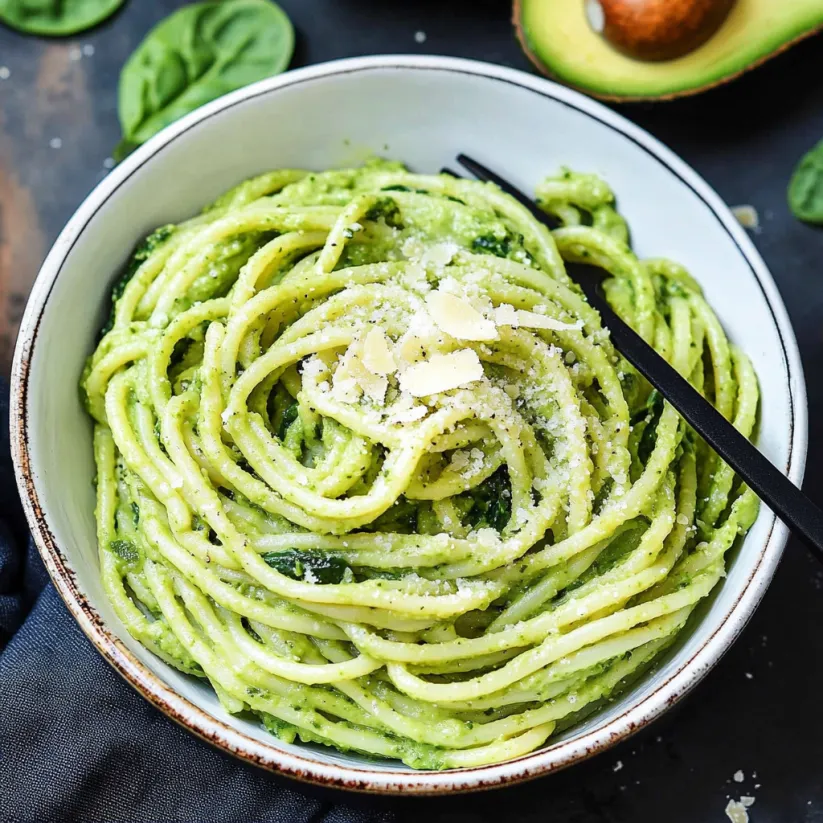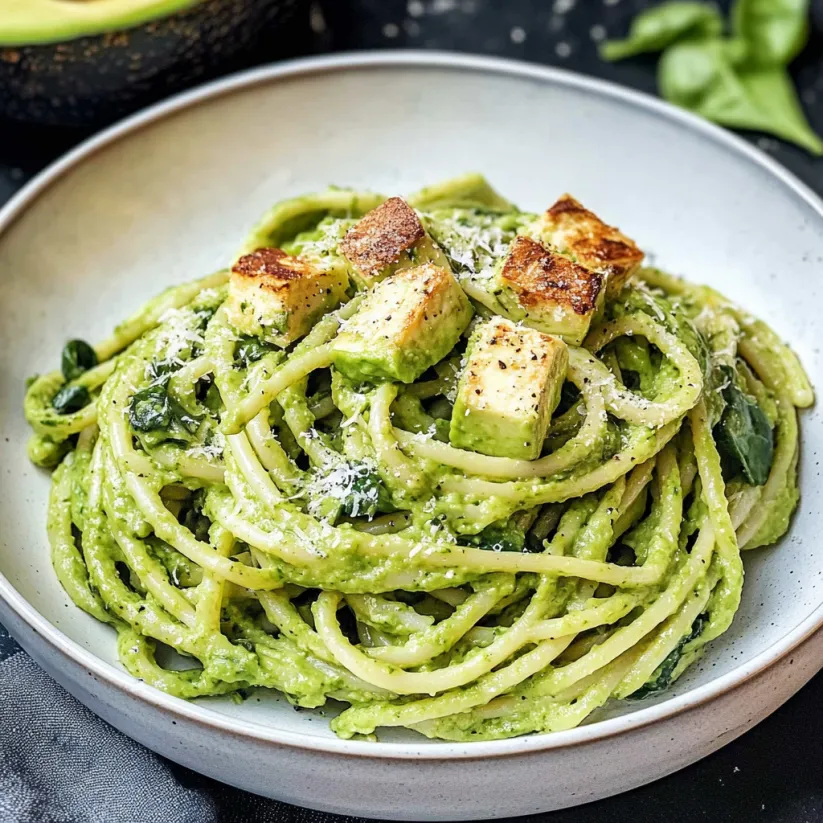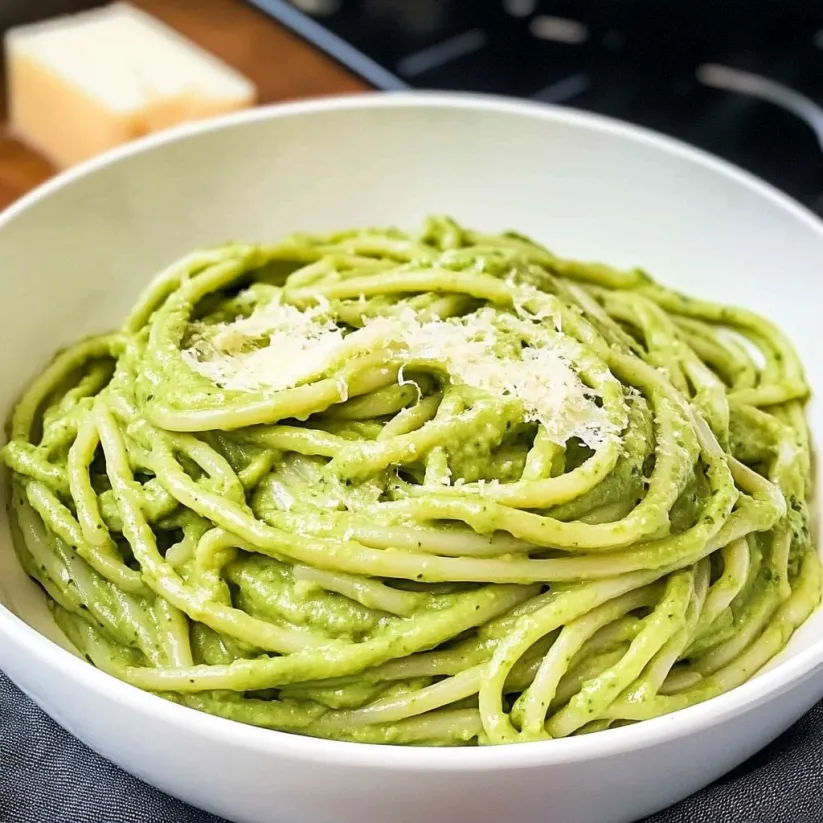 Save Pin
Save Pin
This creamy avocado spinach pasta is my weeknight dinner superhero, combining the velvety texture of ripe avocados with fresh spinach and crunchy pecans. The sauce comes together in minutes while your pasta cooks, creating a luxurious meal that tastes indulgent but is packed with wholesome ingredients.
I discovered this pasta on a night when I needed dinner in a hurry but was craving something more exciting than jarred sauce. Now it's in my regular rotation because my family devours it every time and I love how I can have a restaurant-quality meal without much effort.
Ingredients
- 10 ounces spaghetti or fettuccine: semolina pasta recommended for its texture and ability to hold the sauce
- 1 ripe avocado: look for one that yields slightly to pressure for perfect creaminess
- 1 cup fresh spinach: adds vibrant color and nutritional boost
- ½ cup pecans: provides richness and a subtle nutty flavor
- ¼ cup fresh basil: brightens the entire dish with aromatic notes
- 1 clove garlic: adds depth without overpowering the delicate flavors
- ¼ cup freshly grated Parmesan cheese: use the real stuff for best flavor
- 1 tablespoon freshly squeezed lemon juice: prevents avocado browning and adds brightness
- ¾ to 1 cup pasta water: the starchy liquid creates the perfect sauce consistency
- Salt and pepper: enhance all the flavors
Step-by-Step Instructions
- Cook the Pasta:
- Bring a large pot of generously salted water to a rolling boil. Add your pasta and cook according to package directions until al dente, usually 8-10 minutes. Reserve about 1 cup of pasta water before draining. The pasta should have a slight bite as it will continue to soften slightly when tossed with the warm sauce.
- Prepare the Sauce:
- While the pasta cooks, add the avocado, spinach, pecans, basil, garlic, Parmesan, lemon juice, and ¾ cup of the hot pasta water to your blender. Season with salt and pepper. Blend on high speed for 30-45 seconds until completely smooth and velvety. The sauce should be thick yet pourable. Add more pasta water if needed to achieve your desired consistency.
- Combine and Serve:
- Transfer the drained pasta to a large bowl while still hot. Pour the avocado sauce over the pasta and use tongs to gently toss everything together until each strand is thoroughly coated. The residual heat from the pasta will warm the sauce perfectly. Serve immediately in warmed bowls for the best experience, as this sauce is most vibrant when freshly made.
 Save Pin
Save Pin
The pecans are truly the unsung hero of this recipe. While many pesto recipes use pine nuts, I find pecans offer a more complex flavor and satisfying texture. One evening when making this for friends, everyone kept asking about the mysterious ingredient that made the sauce so special. The pecans create a distinctive nutty undertone that perfectly complements the creamy avocado.
Make Ahead Options
While this pasta is best enjoyed fresh, you can prepare components ahead of time to streamline the process. Toast the pecans up to a week in advance and store them in an airtight container. You can also measure and refrigerate the spinach and basil. When ready to cook, simply boil the pasta and blend the sauce ingredients. This approach preserves the vibrant green color and fresh flavor while still saving precious minutes during dinner prep.
Perfect Pairings
This pasta works beautifully alongside a simple arugula salad dressed with lemon vinaigrette. The peppery greens and bright dressing complement the creamy pasta without competing with its delicate flavors. For protein, consider adding grilled shrimp or sliced chicken breast on top. A glass of crisp Sauvignon Blanc or Pinot Grigio makes the perfect beverage pairing, as the wine's acidity balances the richness of the sauce.
Customization Ideas
This versatile recipe welcomes thoughtful modifications. For a dairy-free version, swap the Parmesan for nutritional yeast. If you prefer more texture, reserve some chopped pecans to sprinkle on top along with extra basil. For heat lovers, add a pinch of red pepper flakes to the sauce or garnish with a drizzle of chili oil. Summer variations can include cherry tomatoes or sweet corn kernels tossed with the finished pasta for bursts of seasonal flavor.
 Save Pin
Save Pin
Commonly Asked Questions
- → Can I make this pasta dish ahead of time?
This dish is best enjoyed immediately after preparation. The avocado in the sauce will naturally oxidize and turn brownish when stored, affecting both appearance and taste. If you need to prepare components ahead, cook the pasta in advance and refresh with hot water before adding freshly made sauce.
- → What can I substitute for pecans?
Walnuts or pine nuts make excellent alternatives to pecans in this dish. Walnuts offer a similar earthy flavor profile, while pine nuts provide a more delicate, buttery taste. For nut-free options, try pepitas (pumpkin seeds) or sunflower seeds.
- → How do I prevent the sauce from being too thick or thin?
Start with ¾ cup of pasta water when blending the sauce, then gradually add more until you reach your desired consistency. The starchy pasta water helps emulsify the sauce and allows you to control the thickness. Save extra pasta water in case you need to thin the sauce when mixing with pasta.
- → Can I use frozen spinach instead of fresh?
While fresh spinach provides the brightest flavor and color, frozen spinach can work in a pinch. Thaw completely and squeeze out excess moisture before blending to prevent a watery sauce. You may need to adjust quantities as frozen spinach is more concentrated than fresh.
- → Is there a dairy-free alternative to the Parmesan cheese?
For a dairy-free version, nutritional yeast makes an excellent Parmesan substitute, offering a similar umami flavor. Use about 3 tablespoons in place of the ¼ cup Parmesan. Alternatively, cashew-based vegan Parmesan alternatives work well, or simply increase the salt slightly to compensate for flavor.
- → How ripe should the avocado be for the sauce?
The avocado should be fully ripe but not overripe. It should yield slightly to gentle pressure and have a dark skin. A perfectly ripe avocado creates the creamiest texture for your sauce. If it's too firm, the sauce may be chunky; if too soft, it might taste overly rich or even bitter.
